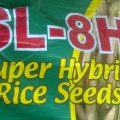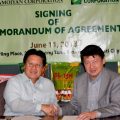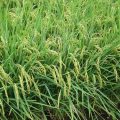Bangladesh sent a mission through its Ministry of Agriculture (MA) to look into tapping into rice seeds in the Philippines through its partnership with SL Agritech Corp. (SLAC) in its aim to export fancy rice.
The mission, led by MA Minister Matia Chowdhury, visited last May 23 SLAC’s Research Center in Brgy. Oogong, Sta. Cruz, Laguna.
The delegation also visited The 252-hectare experimental field in Los Banos, Laguna of the International Rice Research Institute (IRRI).
Chowhury is interested in potential expansion of collaboration with SLAC after the Filipino-developed SL-8H has made a mark in Bangladesh’s hybrid rice sector, accounting for 20 percent of the seed supply.
“Bangladesh’s major export is parboiled rice. Their minister said they’re looking for a business on hybrid rice that they can plant and export. They want high-amylose rice for export,” said Dr. Weijun Xu, SLAC international business officer-in-charge.
SLAC, though, is not committing yet on any rice seed agreement. It is studying the possibility of adding a new variety of hybrid rice to be produced in Bangladesh.
The mission includes representatives from Bangladesh-based Stress Tolerant Rice for Africa and South Asia (Strasa) and officials from different cities and municipalities of Bangladesh like Tangail, Barisal, and Rangpur.
These are Shawkat Momen Shahjahan, Tangail-8; Kh. Abdul Baten, Tangail-6; Abul Kalam Azad, Rangpur-6; Ahmed Nazmin Sultana, 306 Women Set-6; Md Mazibor Rahman Sarwar, Barisal-5; Mohammad Shahjalal; Md. Hemayet Hussain; Anupam Shahjahan Joy; Momotaj Khandaker; ATM Akthar-Hossain; and Dr. Mohammad Abdul Bari, country manager, Strasa-IRRI-Bangladesh office.
Bangladesh’s government is grateful that SLAC had allowed Bangladesh to produce SL-8H seeds right in Bangladesh’s farms, contributing to this developing country’s non-importation of rice in 2013.
“We’re very happy their minister of Agriculture visited us. We’re the biggest in hybrid rice seed in Bangladesh,” said SLAC Chairman Henry Lim Bon Liong.
Other countries had not allowed their locally-developed seeds to be planted there. Bangladesh just imports the seeds from other countries (like India or China).
The Bangladesh government itself through the Bangladesh Rice Research Institute (BRRI) has direct partnership over 45 years with IRRI that involved capacity building and exchange of germplasm, a collection of genetic resources like rice seeds that may be used for the development of good varieties.
Bangladesh is also exploring use of more stress-tolerant rice varieties like drought tolerance.
Bangladeshi farmers found SLAC’s SL-8H seeds to be surpassing the performance of imported other seeds, according to Anwar Faruque, Bangladesh Ministry of Agriculture additional secretary.
While Philippines’ agriculture/” title=”View all articles about Department of Agriculture here”>Department of Agriculture (DA) Sec. Proceso J. Alcala has started a policy seeking opportunities in the export market as part of sustaining rice self-sufficiency aim, Bangladesh is apparently in the same boat.
Bangladesh is now trying to export rice after several years of importing around 500,000 metric tons (MT) of rice yearly. Imports peaked to 1.48 million MT in 2011 (based on USDA report).
In April 2012, Bangladesh removed a policy banning export of aromatic rice. Its opportunities to export are ripe. It is noted to be presently world’s fourth largest rice producer based on an estimated 34 million MT of rice production as of 2012.
Xu said that its for probable export, Bangladesh wants to plant a fancy rice hybrid variety that is similar to the Jasmine rice of Thailand.
“They don’t want Jasmine rice (for their own consumption). But they want to plant a similar high-amylose rice so they can export it,” said Xu.
Bangladesh already adopted in 2009-2010 the submergence-tolerant rice developed by IRRI which was specifically bred for planting in flooded land.
This rice plant has the SUB1 (submergence) gene that can withstand complete submergence in water from 10 to 14 days. It can revive plant growth when floods recedes.
Bangladesh also utilized IRRI-BRRI’s saline-tolerant rice variety which is suitable for land where brackish water (sea water and fresh water mix) seeps in.
###
About Parboiled Rice
Parboiled stands for partially boiled rice in the husk form, or before milling. Partial boiling raises nutrition content of rice, meaning it is more nutritious than white rice although a little less nutritious than brown rice (less refined with bran intact). Parboiling originated in India and has been a tradition in Bangladesh. But North Americans adopted parboiling with its ability to retain nutrients. This is particularly three-resistant starch that functions as a prebiotic which is good for gut health, according to the, Latinoamericanos de Nutricion.
About Submergence Tolerant Rice
IRRI and its partners developed submergence tolerant rice since flooding is a common problem in rainfed lowland rice affecting 15 million hectares yearly in South and Southeast Asia, according to the International Rice Research Notes.
Climate change, manifested in extreme weather conditions such as excessive or heavy rains, further worsen flooding situation. A solution to this is the submergence-tolerant rice which uses high-yielding rice varieties like the Ir 64 as parent. The Philippines adopted Submarino 1, (also called NSIC Rc 194) in 2010.
The Bangladesh Rice Research Institute also released Submarino 1 in 2010 known as BRRI dhan51. The other submergence-tolerant variety it released was BRRI dhan52 which can produce 4.5 to five tons per hectare despite the 10 to 14 days flooding period.
In 2011, more than one million farmers planted the flood-tolerant variety mainly in Bangladesh and India, according to Ronald Laboratory.
About Saline-Tolerant Rice
As climate change poses threats on melting of polar ice sheets as a result of global warming, salty sea water submerge coastal areas, affecting farm lands. Saline-tolerant rice has been developed for these salt-intruded farm lands.
Bangladesh has adopted saline-tolerant rice varieties BRRI dhan53 and BRRI dhan41 which are suitable for brackishwater-affected farms.
In the Philippines, the saline-tolerant variety NSIC Rc 108 yielded 3.12 tons per hectare in a field trial in Bicol Region conducted in 2010-2011. This was higher than 1.95 tons per hectare yield of farmers using traditional seeds.
“NSIC Rc 108 is a cost-efficient option than farmers’ existing variety. Use of early maturing saline tolerant variety offers an alternative option for a quick around establishment,” according to DA Region 5 researchers Luz R. Marcelino and E.B.Dela Torre.
Saline tolerant varieties can also be early-maturing (harvestable earlier) by 10 to as much as 25 days compared to conventional varieties (traditionally 115-120 days).
About SL AGritech Corp. (SLAC)
SLAC is the Philippines’ biggest producer of hybrid rice seeds and is the country’s pioneer in hybrid rice research and development (R&D). At a time when businesses veer away from agriculture owing to its inherent risks brought about by weather, nature-related, and calamity-related uncertainties, SLAC’s parent firm Sterling Group of Companies, stuck its neck out, took the risk, and invested capital in hybrid rice R&D. Today, SLAC produces popular hybrid rice seed SL-8H which has helped uplift the lives of many Filipino farmers through higher rice yield. By empowering them through training by SLAC technicians in precision farming skills and the pride to sell good-quality rice, hundreds of farmers are now able to educate their children, become farm entrepreneurs, and enjoy a higher standard of living. Farmers are able to access otherwise hard-to-reach financing facilities through the company’s “Plant Now Pay Later” program. This contract growing which is under the company’s Corporate Social Responsibility program also gives farmers the assurance of a market which is one of the most difficult tasks in the rice farming value chain whose absence can bring untold miseries to many farmers. SLAC buys their produce 100 percent at higher price compared to market From this contract growing program, SLAC produces the Dona Maria premium rice Miponica and Jasponica, the “best tasting rice in the Philippines, probably the whole world.” The company has international partnerships for hybrid rice seed production in Asia (Vietnam, Bangladesh, Indonesia, Myanmar and Cambodia) and Africa in a humanitarian aim to help solve food security threats and global hunger.
For any questions, please call Ms. Joh Dungca, 0917-558-6508; for interview requests, Ms. Analiza C. Mendoza, 0923-436-3177.





